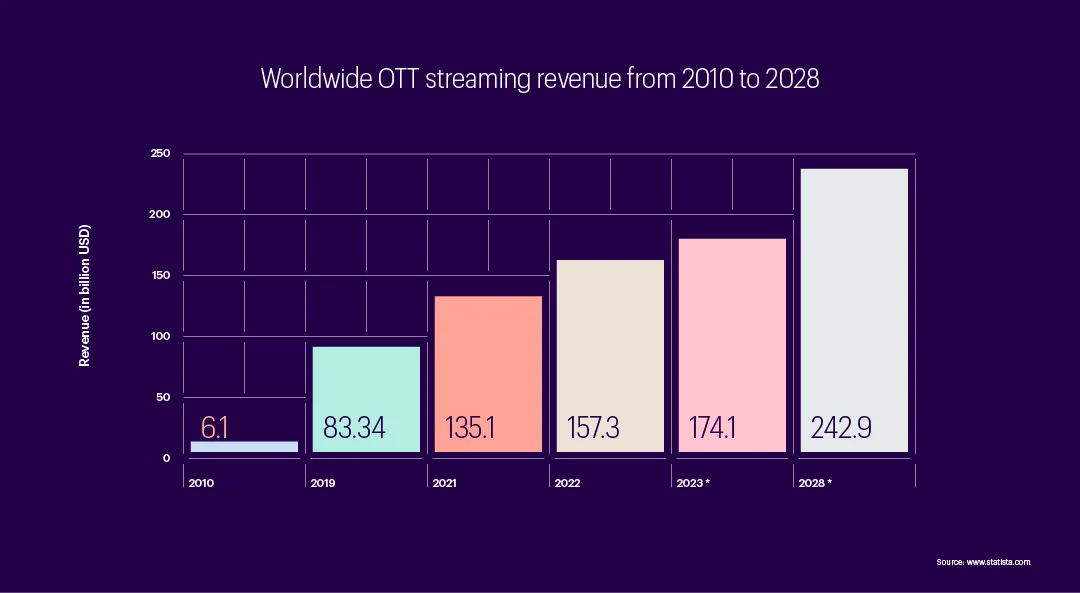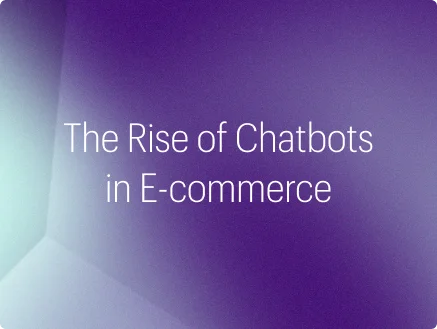Content streaming services have been showing steady growth in the last decade, but they have exploded in popularity in the last couple of years. When it comes to video content-streaming services, there is a large variety of them based on the kind of content they host, payment plans, and advertisement models.
The industry has become incredibly competitive, and new streaming platforms exist to cater to even niche areas of interest. In such a competitive playing field, older methods of functioning are no longer proving effective in helping brands stay ahead. AI and analytics are now providing streaming services a significant advantage over their competition. It helps brands retain their customer base, manage their content catalog, and sustainably grow the organization.

OTT TV and Video revenue are expected to reach 242 billion US Dollars by 2028, nearly double the figure reported in 2021. [5]
What kinds of data do streaming services generate?
Digital media services, and especially streaming services, generate a lot of data every day. The data generated can be broadly classified into two—Content Data and Audience Data—which can then be further divided into separate sub-divisions.
Content data involves measuring easily retrievable metadata like the popularity, engagement, and consumption of movies and TV shows, as well as data about the content—such as its runtime, genre, content tags, cast and crew members, etc. AI tools are also now able to extract even more data from within the content itself such as using computer vision and object recognition to identify objects within the film or building datasets with keywords from dialogue using speech recognition. This data is primarily used for classification and aiding in search capabilities but can also greatly aid and inform the content creation, acquisition, and curation process [1].
Audience data can be further divided into personal data, demographic data, and behavioral data. Demographic data—their age, gender, location, etc.—is used to cluster members of the audience into groups with known general preferences. Behavioral data provides highly specific information about a single user like what they clicked on, when and how long they watched something, when and where they paused a video, what they searched for, how long they scroll through their page before selecting what to watch, how long they take to finish a movie or a series, feedback submitted, billing details, and so on [1]. This data is then used to build a detailed profile for each individual user.
How can companies effectively use all this data to overcome their challenges and for competitive advantage?
Preventing churn with the help of AI
The most important challenge faced by streaming platforms in today’s highly competitive world is the inability to retain customers. The Direct-to-consumer (D2C) subscription-based streaming industry has blown up over the past few years [2], accelerated by COVID-19, completely changing the way most people consume media. However, with increased viewership also came higher levels of competition, as more players rushed in for their chance to strike gold in the industry. Customers are now spoilt for choice and overall standards for quality of the catalog, content experience, customer service, user interface, and cost efficiency have all steadily risen. Streaming services now have to be extra careful regarding any pricing, content, or interface changes they make. [1] In such a landscape, successful brands are those that can keep their subscriber rates strong while mitigating churn i.e., without losing existing customers.
Holding on to a customer’s loyalty and interest must now become the media and entertainment industry’s primary objective. How can AI and data analytics help streaming platforms reduce churn?
Tailored recommendations: A customer will keep returning to a platform whose interface feels intuitive, and whose content suggestions feel appropriate—Netflix and YouTube, two of the most popular streaming platforms are especially known for their recommendation algorithms [3][4]. These algorithms are able to continuously gather information and learn on their own to increase the quality of the suggestions [3]. Industry leaders are even building tools with the capability to generate effective content recommendations within 30 seconds of a new user joining the platform [2].
Thumbnail personalization: In addition to a catchy title, appealing thumbnails are an effective way to increase the viewership of a particular video. However, since different sections of the audience have differing tastes, it is not possible to have a single thumbnail that appeals to everyone. Streaming platforms instead use AI to generate a wide variety of thumbnails and deploy the ones any given viewer is likely to click on. [3]
Optimal streaming quality: Predictive AI tools can be used to foresee when streaming platforms would experience higher traffic rates than normal. This information can then be used to strengthen the platform to prevent crashes during peak usage periods. These tools are also able to improve video quality during such peaks by placing video assets near subscribers in advance. [3]
Personalization of search: The search function can be transformed from being simply utility-driven through personalization of the results. With the huge content catalogs that most streaming platforms feature, it can be difficult for customers to quickly locate the specific media they are looking for. However, using the same data that personalizes content recommendations, streaming platforms can also implement personalized search results tailored to each user. This can help users find exactly what they are looking for in a shorter amount of time, and make the platform feel far more intuitive and comfortable to use. [1]
Content acquisition: Content is the bedrock for any successful streaming platform. In an atmosphere of shifting customer loyalty, it is the quality of a platform’s content that draws and keeps users to itself. Data shows that, during the pandemic, a majority of users signed up to a streaming service to watch one specific show. [1] However, users will not stay subscribed if they can’t find other content they like on the platform. The way to avoid this churn is to constantly keep ahead of trends by acquiring and creating the right content at the right time. AI and analytics tools can make use of clickstream data and customer feedback to identify what kinds of content users enjoy the most. This would then inform the platform’s content acquisition, curation, and lifecycle processes. [2]
Curating offers: Another important factor that increases churn is price [1]. With ample options, consumers would choose to spend their money on what satisfies them the most. Discount periods and free trials are effective tools for getting a new user to try out the service and experience its features before making an economic commitment. AI could recommend the best time and manner to implement these offers. Analytics could also provide suggestions on how to best bundle streaming service subscriptions, for e.g., with product purchases, SIM card connection, or even other streaming platforms [2].
What else can AI help with?
Data management: Achieving data maturity helps a company bolster its analytics and increase efficiency in all other areas. This requires set systems and processes for collecting and managing the data available to them. AI and analytics tools can help ensure the smooth functioning of these systems.
Distribution strategy: In addition to recommending what content to acquire and create, AI can also help entertainment services optimize their distribution strategy—when to release it, how long to keep it on the platform, and when to promote it.
Marketing insights: AI and data analytics can significantly enhance a brand’s marketing efforts by providing detailed insights on past campaigns that can inform future campaign decisions.
Content filtering: Content filtration is an important requirement for streaming platforms that allow users to upload their own videos. However, platforms like YouTube have millions of users uploading videos each day, and it becomes difficult to manually approve and filter them. AI tools can help automate this process, with manual approval required only in special cases. Streaming platforms make use of AI in this way to categorize videos, root out misinformation, and add warnings to sensitive content. [4]
The future of streaming
The streaming industry will continue to grow, but new players will find it increasingly difficult to sustain themselves without a strong data-oriented approach. The leaders in this field will be those who can anticipate what the customers want before any of their competitors. Brands must invest in data analytics, AI, and Machine Learning to drive relevant, individualized experiences around content that matters to viewers [2]. Aside from the use cases already mentioned above, streaming platforms are also greatly experimenting with AI systems that can offer unique content experiences—Netflix’s 2018 interactive film Black Mirror: Bandersnatch is an excellent example of how streaming platforms can pioneer innovation in the media and entertainment industry. Brands must also recognize that we are heading into a new age of media, internet, and privacy, where they must improve their first-party data strategies in a cookie-less world. The next phase of the streaming wars will see success stories backed by secure, first-party data and mature analytical systems.
This article is part of a series on how AI and Data Analytics are reshaping the Media and Entertainment industry. Read the other articles to find out more about how E-sports and Entertainment have been changing in the last few years.
Bibliography
1. Canet, Lluis. “Google Cloud Brandvoice: Churn It down: How Media Companies Can Use Ai to Keep and Win Subscribers.” Forbes, June 13, 2022. https://www.forbes.com/sites/googlecloud/2022/06/13/churn-it-down-how-media-companies-can-use-ai-to-keep-and-win-subscribers/?sh=6988bdd63744.
2. Sobel, Steve. “How Data Will Dictate What’s next in the Streaming World.” RTInsights, January 4, 2023. https://www.rtinsights.com/how-data-will-dictate-whats-next-in-the-streaming-world/.
3. Simplilearn. “Netflix Recommendations: How Netflix Uses AI, Data Science, and ML: Simplilearn.” Simplilearn.com, October 26, 2023. https://www.simplilearn.com/how-netflix-uses-ai-data-science-and-ml-article.
4. Maxwell. “YouTube – A Super Platform Driven by AI”. d3.harvard.edu, April 18, 2022. https://d3.harvard.edu/platform-digit/submission/youtube-a-super-platform-driven-by-ai/.
5. Statista. “Video Streaming Worldwide.” Statista, May 2023. https://www.statista.com/study/68959/global-video-streaming-market/?locale=en.ni



